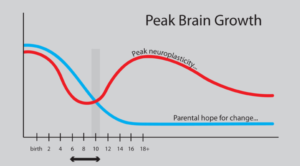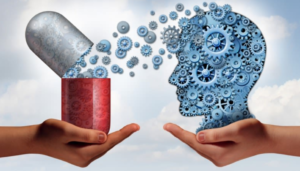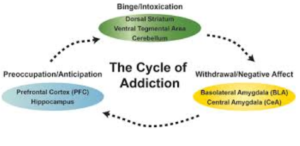The human brain is only fully developed around age 25. Because of this, it is easier for adolescents to become addicted to drugs.
Of all organs, the human brain is unique in that it is designed to change – both rapidly and radically. This quality is known as neuroplasticity: self-perpetuating change in synaptic connections brought about through repeated experience. In simple terms, this is learning – when you learn something new, the brain itself changes its physical configuration. While neuroplasticity is present in the human brain throughout an individual’s entire lifespan, however, it occurs at its greatest rate in the first 18 to 24 years of development – specifically in the first four to six years and the four to six years of puberty.

This means that the ability to learn new behavior significantly increases in these time periods; remember, because of the way addictive drugs affect the reward pathway, addiction is a learned behavior. When a drug increases the amount of dopamine in a synapse, the brain is only able to learn to decrease the amount of receptors on the postsynaptic neuron because of this plasticity. Therefore, in a period of increased neuroplasticity, youths and teens have a greater potential to learn addictive behavior.

However, while addiction is a learned behavior, the continuation of addiction is characteristic of an inability to learn. When addictive drugs create a physical dependence by requiring the drug to produce an adequate amount of neurotransmitter to bind to whatever receptors remain, your brain can’t build new synaptic connection since it relies on the drug to function correctly. And since plasticity is key to development, the youth brain not only can become addicted more easily but also has a greater risk of developmental long-term impairment.
In addition, recall that the reward system connects to many important centers of the brain – including the amygdala, hippocampus, and prefrontal cortex. The hippocampus is involved in the storage of long term memory, and since the youth hippocampus forms these connections faster and in greater amounts, the learned behavior of drug addiction becomes stored in the youth brain quicker. This is another reason why adolescents are susceptible to drug abuse. Meanwhile, the amygdala, by controlling the various emotions associated with various intrinsic and episodic long term memories, plays a role in the psychological aspect of addictive drugs. When suffering from a withdrawal, the amygdala associates the fear and discomfort of the body with a lack of drugs, creating a psychological need to seek relief by taking a drug. Thus, addictive drugs often act by creating a psychological dependency in addition to a physical one.
Most important of these structures to addiction, however, is the prefrontal cortex. On the most basic level, as the prefrontal cortex, which is only fully developed at age 25, controls basic decision making in regards to rewards and values, an undeveloped prefrontal cortex lets adolescents embark on the path to addiction without considering the full implications of their actions.

However, on a deeper level, new imaging studies suggest that stimulants, with a few exceptions, actually drastically increase prefrontal cortex activity. This has been known to lead to an increased prioritization of drug-related goals and other similar conditioned responses (such as drug anticipation and increased tolerance) in the developing adolescent brain. Youths and teens end up finding addictive drugs more rewarding as a result, and have a greater chance of becoming dependent.

In addition to increased adolescent neuroplasticity and its effect on various brain structures, recent research has been conducted on a particular protein in the brain eIF2. The activity of this molecule significantly decreases in youth when addictive drugs are taken, yet remains at the same level in adults. A decrease in eIF2 increases the connectivity between dopamine-transmitting neurons in the reward pathway, offering evidence that addictive drugs have a directly stronger effect on the developing brain in the pure action of the drug itself. However, this also opens up new opportunities for recovery – if the action of this protein can be increased, then it may be easier for victims to fight through their addictions.